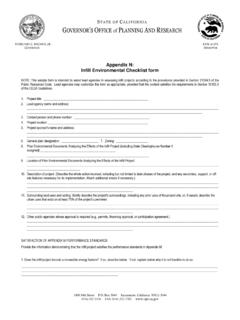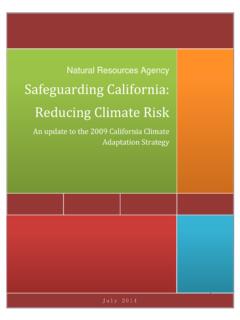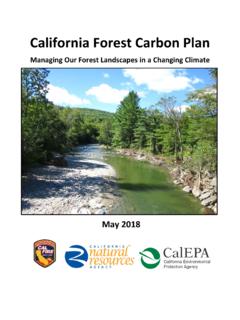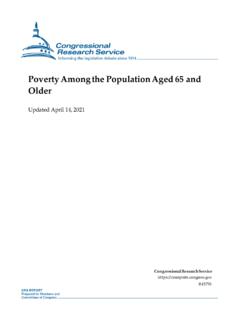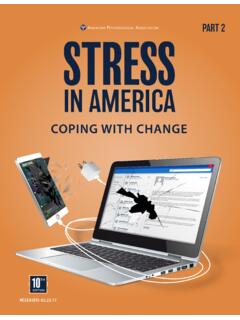Transcription of Extreme Heat Action Plan - resources.ca.gov
1 BUILD PUBLIC AWARENESS AND NOTIFICATION 1 DRAFT Protecting Californians Amidst Extreme Heat: A State Action Plan to Build Community Resilience TABLE OF CONTENTS Executive Summary .. 2 Introduction .. 3 Action Track: Build Public Awareness and Notification .. 5 Goal 1: Build public awareness about Extreme heat and its impacts through targeted communications campaigns .. 6 Goal 2: Support actionable climate science and research to inform risk assessment and decision-making .. 8 Goal 3: Improve accuracy and accessibility of heat modeling and data to inform decision-makers .. 12 Action Track: Strengthen Community Services and Response .. 15 Goal 1: Invest in Social Resilience .. 15 Goal 2: Protect California s workers and economy from the impacts of Extreme heat .. 17 Goal 3: Support local planning and response measures to Extreme heat events.
2 21 Action Track: Increase Resilience of our Built Environment .. 25 Goal 1: Protect critical infrastructure .. 25 Goal 2: Support heat resilient and cooler communities through relevant regulations and codes .. 28 Goal 3: Invest in cool buildings and surfaces .. 34 Goal 4: Utilize science-based frameworks and tools .. 37 Action Track: Utilize Nature-based Solutions .. 39 Goal 1: Promote nature-based solutions .. 39 to reduce Extreme heat risks .. 39 Goal 2: Support nature s ability to withstand and adapt to increasing temperatures .. 42 Goal 3: Reduce heat risk to water supply and systems .. 46 BUILD PUBLIC AWARENESS AND NOTIFICATION 2 EXECUTIVE SUMMARY California s best climate science projects that every corner of our state will be impacted in years and decades to come by higher average temperatures and more frequent and severe heat waves.
3 Extreme heat threatens public health and safety; economic prosperity; and communities and natural systems. It also poses profoundly disproportionate consequences for the most vulnerable among us. This plan outlines a strategic and comprehensive set of state actions to address Extreme heat, and serves as an update to the Preparing California for Extreme Heat Guidance and Recommendations report released in 2013. The substance and organization of this plan was guided by extensive public input collected over the course of 2021, including through three public listening sessions, ten regional workshops, and numerous consultations with California Native American tribes. Actions in the plan are organized into four tracks (1) Build Public Awareness and Notification (2) Strengthen Community Services and Response (3) Increase Resilience of Our Built Environment and (4) Utilize Nature-Based Solutions.
4 These tracks include existing and recommended state actions to address Extreme heat. The Administration is committed to continued scoping and exploration of these actions. Eight areas of near-term focus include: Implementing a statewide public health monitoring system to identify heat illness events early, monitor trends, and track illnesses and deaths. Cooling schools in heat- vulnerable communities and support for climate smart planning. Accelerating heat readiness and protection of low-income households and expanding tree canopy in communities most impacted by Extreme heat. Protecting vulnerable populations through increased heat risk-reduction strategies and codes, standards, and regulations. Building a climate smart workforce through training partnerships and apprenticeships in jobs and careers that address Extreme heat.
5 Increasing public awareness to reduce risks posed by Extreme heat. Supporting local and regional Extreme heat Action . Protecting natural systems, including fish and wildlife, from the impacts of Extreme heat. BUILD PUBLIC AWARENESS AND NOTIFICATION 3 INTRODUCTION California s best climate science projects that every corner of the state will be impacted in years and decades to come by higher average temperatures and more frequent and severe heat waves. These changes will pose a risk to every region and sector across natural, built, and social systems. The 2022 Action Plan outlines California s all -of-government approach to mitigating the health, economic, cultural, ecological, and social impacts of increasing average temperatures and heat waves. It constitutes California s response to what has become known as Extreme heat and accompanying Extreme heat events.
6 WHAT IS Extreme HEAT AND WHAT ARE ITS IMPACTS? Climate change is increasing temperatures across the planet and in California. Extreme heat refers to temperatures that are well above normal conditions and Extreme heat events are consecutive unusually hot days and nights for a given area. Different regions of our state experience Extreme heat differently; some areas accustomed to hot temperatures are experiencing very hot conditions while other areas that have been historically cool are experiencing warmer temperatures. Increasing temperatures also impact people differently. For vulnerable people, including aging populations, children and those with certain health conditions, and for people without access to air conditioning or shade, Extreme heat can be dangerous even deadly. This Action Plan responds to Extreme heat as it is experienced differently across California and seeks to support tailored approaches across California s diverse microclimates.
7 Average annual temperature increases experienced over most of California have already exceeded 1 F, with some areas exceeding 2 F. The daily maximum average temperature, an indicator of Extreme temperature shifts, is expected to rise F F by 2050 and F F by 2100. Heat waves that result in public health impacts, also referred to as heat-health events, are also projected to worsen throughout the state. By 2050, average heat-health events are projected to last two weeks longer in the Central Valley and four to ten times more often in the Northern Sierra region. Heat ranks amongst the deadliest of all climate change-driven hazards in California, and heat waves in cities are projected to cause two to three times more heat-related deaths by mid-century. Climate vulnerable communities will experience the worst of these effects, as heat risk is associated and correlated with physical, social, political, and economic factors.
8 Aging populations, infants and children, pregnant people, and people with chronic illness are especially sensitive to heat exposure. Combining these characteristics and existing health inequities with additional factors, such as poverty, linguistic isolation, housing insecurity, and the legacy of racist redlining policies, can put individuals at disproportionately high risk of heat-related illness and death. Extreme heat also threatens California s natural systems. Increasing temperatures, for example, lead to exacerbated risk of wildfire; drought and its effects on the health of BUILD PUBLIC AWARENESS AND NOTIFICATION 4 watersheds; and the direct effects of heat on plants and animals resulting in reduced fitness, increased stress, migration, and death. This Action Plan leverages expertise across state government to address the broad range of Extreme heat impacts on California and builds a strong foundation for enhanced and equitable climate change adaptation.
9 UPDATING CALIFORNIA S RESPONSE In 2013, the State released Preparing California for Extreme Heat: Guidance and Recommendations. The document summarized climate projections for increased temperature and Extreme heat conditions for California and presented state agency recommendations. Coordinated by the California Department of Public Health and the California Environmental Protection Agency, the report s recommendations focused on addressing Extreme heat s impacts on human health. This document updates and builds upon actions initiated in the 2013 report . The substance and organization of this draft Extreme Heat Action Plan was guided by extensive public engagement. In addition to input received through ten regional workshops and numerous consultations with California Native American tribes, the state held an Extreme Heat Workshop Series to gather recommendations on priority state actions and areas of focus for the Action plan.
10 Actions in the plan are organized into four tracks: 1) Build Public Awareness and Notification; 2) Strengthen Community Services and Response; 3) Increase Resilience of the Built Environment; and 4) Utilize Nature-based Solutions. These tracks include existing and recommended state actions to address Extreme heat. It will require time, effort, and funding to carry out these strategies. The pace of implementation will depend upon our collective effort and the feasibility and availability of resources. The 2021 Budget included a $300 million General Fund set aside over two years to support investments that reduce urgent risks and build long-term resilience to the impacts of Extreme heat across California. The Administration will use the Extreme Heat Action Plan to determine investments that will be prioritized for implementation with this funding set aside.






